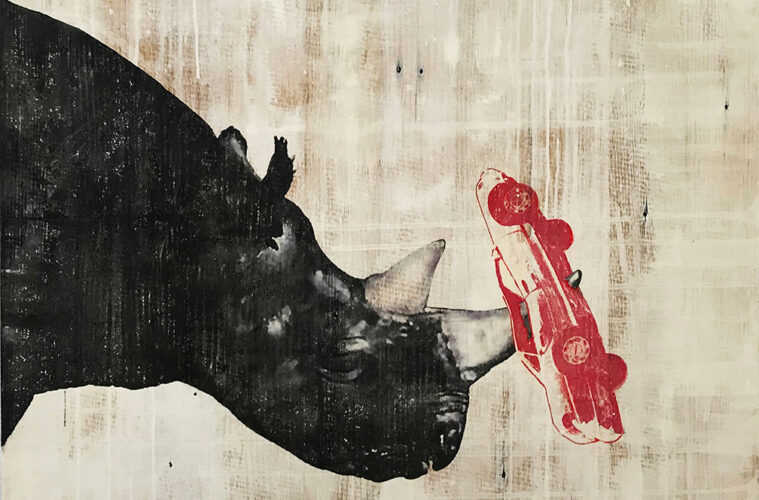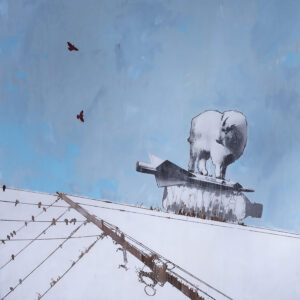BY SHALEEN DESTEFANO
If we’ve learned anything from our artist interviews, it’s that art and philanthropy often go hand-in-hand. In fact, they compliment one another. This belief was underlined in our conversation with Brett Matarazzo. His art is inspired by our environment and offers a voice to the devastation that is the result of man with nature. His dedication to making a difference is inspiring, so we feel so grateful to have had the opportunity to learn more about his history and process.
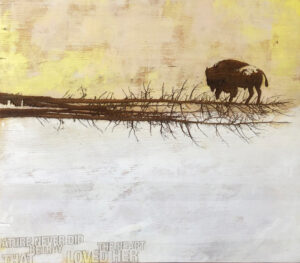 Over the last two decades, you’ve developed a style that is uniquely vintage, environmentally-conscious and inspired, while maintaining a modern and functional aesthetic. Tell us a bit about your journey as an artist and how your work has evolved over the years.
Over the last two decades, you’ve developed a style that is uniquely vintage, environmentally-conscious and inspired, while maintaining a modern and functional aesthetic. Tell us a bit about your journey as an artist and how your work has evolved over the years.
I was schooled and reared in Colorado, which really inspired my love of nature. My father was a bit of a tree nut, and as a result, I probably planted 100 trees before I was 23. I went to the University of Denver and graduated with a BFA in design. I’ve always liked the conceptual side of art, and solving creative problems, which led me to start my professional journey in advertising and design, first as an intern in college, then as an Art Director and Associate Creative Director at the Integer Group, shaping and defining my aesthetic, social beliefs, and visual story-telling.
During my time at Integer, I never stopped creating art. My artwork evolved naturally and organically to mixed media from my love of wood as canvas, in addition to my early love of photography and bold functional design and typography. In my design background, I was always experimenting with materials, and being subjected to many tools and techniques that gave me a lack of fear in mixing these elements together. So today my work employs custom built repurposed wood canvases, acrylic paint, occasionally ink or paper, with digital and heat transfer and laser etching. Where has this process lead me? I suppose after I realized the distaste I had for some of the commercialism of advertising and over consumption, it led me down the path of full-time artist and repurpose evangelist. I started to create urban pop-up galleries in unfinished spaces in the late 2000s to showcase and emphasize the enviro-social message of my work. That’s when I learned to just go and do it, not to wait for someone else to tell me how. I put on 5 or 6 shows from Aspen to Denver. This early exposure gave way to participating in some more established and curated group shows, which evolved my work towards installation and sculptural art. I met and got married to my amazing wife Dr. Bridget Matarazzo, who is a psychologist, and had two amazing children, Autumn and Emory, and left the ad business behind for full-time artist and dad duties.
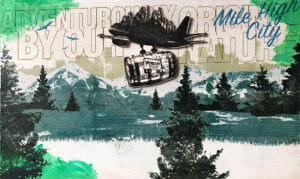 A large part of my growth and journey into the greater art community was joining and helping establish ZEEL art collective & gallery on social issues. The process, friendships, mentoring and introduction to the larger art community was awesome. It stoked the passion for creating and curating for amazing groups of artists around a central social theme, starting conversation and bringing art to community. These experiences were foundational in the development of the BRDG Project, the community-focused art gallery co-founded by myself and Michael Dowling.
A large part of my growth and journey into the greater art community was joining and helping establish ZEEL art collective & gallery on social issues. The process, friendships, mentoring and introduction to the larger art community was awesome. It stoked the passion for creating and curating for amazing groups of artists around a central social theme, starting conversation and bringing art to community. These experiences were foundational in the development of the BRDG Project, the community-focused art gallery co-founded by myself and Michael Dowling.
Your work explores the personal struggle with man overtaking nature and how nature in turn responds. Can you tell us a bit more about this theme in your work?
I care deeply about nature and how we treat her, and I’m somewhat of a contradiction. I love humans and believe they are invariably good individual creatures, but as a whole humanity seems tragically flawed and struggles to treat itself or nature well. My work is derived from this conflict, how we perceive and co-exist with our natural and man-made environment, an exploration and commentary on the human condition, over consumption, and the environmental impact from it. I juxtapose these two things, an element/instrument of humanity (usually something industrial) and an element of nature to create a tension, to cajole the senses, and lead to conversation or thought about how there is always an impact, large or small, on the natural world from this human experiment.
As I mentioned, my medium to start this greater conversation is reclaimed and repurposed wood. I like to call it post-industrial tear-out. I’m a dumpster-diver and scavenger of sorts, always looking to find beautiful discarded remnants. I’ve always loved the beauty of wood as canvas, alive and deep with history, but I have almost exclusively used reused wood for the last 14 or 15 years. I believe deeply that the best way for anyone to be environmentally conscious in this society is to repurpose something old into something new and useful, and forgo the waste stream, and the energy and material use of buying new. I call this the foundation of my work, it all starts there. I am also a lover of the human history, and behind every 100 year old 2×4, wood floor plank, square nail or beam, each one tells a tremendous story: who was the person that ran the saw that made those saw marks, who hammered in those square nails, how did they live, what was there life like? Again the contradiction, I love these individual humans and their lives, regardless of what their society will become, the damage to the animals and ecosystem they will do. Keeping these conversations and ideas present in idea and community through art is my ultimate goal.
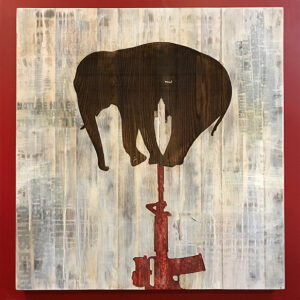 You, along with your friend Michael Dowling, Co-Founded the BRDG Project (pronounced “bridge project’) in January 2021. Can you tell us more about this art space and its mission?
You, along with your friend Michael Dowling, Co-Founded the BRDG Project (pronounced “bridge project’) in January 2021. Can you tell us more about this art space and its mission?
The BRDG Project is a contemporary art space that Michael and I created with the goal of bringing local artist-driven and thought-provoking arts back to the heart of Denver’s shifting neighborhoods, by bridging artist, gallery, youth and under-served communities together in an accessible and engaging space for contemporary expression and learning. Years of development & growth have reshaped Denver’s original city neighborhoods. Local art galleries and collectives were part of the community and brought unique cultural voice and contemporary art and expression to these neighborhoods, but rising real estate values have seen the arts pushed out or to other counties, leaving a tremendous cultural and community artistic void, that the few remaining commercial galleries don’t fill. This left us asking – how can you have vibrant, young, and world class city neighborhoods (like Lower Highland) without community-building, artist-driven and thought-provoking art?
Michael and I attended the same Denver high school, but only reconnected 6 years ago through a mutual friend. As artists, we feel the role of creativity, and specifically local conceptual artwork, is essential to any neighborhood. It allows for discourse around the issues and values of our time and honors community. This stokes our passion for working with and creating a platform for amazing local artists and students around a central idea or social theme, and starting those conversations.
This shared vision has guided us over the last few years as they have cultivated business and artist collaborations to keep local art in Denver communities, to support artistic expression, arts education and artist growth. The BRDG Project is an embodiment of that collaboration. We’ve used roughly 4000 square feet of space in the historic Zang building that was generously provided by Unico Properties. The space has three distinct gallery areas, which we use together and separately for robust programming.
Since we opened in January 2021, we have had 31 diverse exhibitions & 20+ performances, featuring over 175 artists, serving over 3000 patrons, and 50 students from 3 universities, to bring accessible contemporary arts back to the North Denver community.
Can you tell us about your upcoming exhibit that will honor trees?
My very good friend, long-time colleague, and exceptionally talented artist, Terry Gardner, and I have been collaborating and planning a show for over three years around the idea of honoring trees. This is finally culminating in this Earth Day 2022 show. Trees are symbols of connections. They communicate through a vast social network, they are aware, and if we listen, they are trying to tell us something. This show will educate and inspire action by connecting art, artists, and the community through a range of media and personal interpretations. It has been said — only people who understand trees are capable of protecting them.
“The Language of Trees” will be an exhibition of growing conversation and awareness around the beauty, health and understanding of trees. Through this group exhibition at the BRDG Project we aim to educate and inspire action towards a healthy planet. The gallery will be fully activated with art by twenty local artists, film screenings, interpretive dance, an environmental speaker, and a tree seedling giveaway! The exhibit will be on display starting Friday, April 15 at 1553 Platte Street, Denver, under the Highland Bridge, with a reception on Earth Day, Friday, April 22, 6-10pm and a closing night event on Thursday, April 28, 6-9pm. The show is also on view Monday–Friday 10am-5pm, Saturday 11 am-7pm, Sunday 12-4 pm.
The exhibiting artists are: Faatma Be One, Michael Dowling, Lares Feliciano, Terry Gardner, Brian Gillespie, Natalie Ingle, Mike Keene, Tara Kelley-Cruz, Charles Livingston, Lauri Lynnxe Murphy, Brett Matarazzo, Shannon Mello, Jessica Moon Bernstein-Schiano, Jacob Mora, Christine Nguyen, Alexandrea Pangburn, Nicole Predki, Kevin Sloan, Eriko Tsogo and Michael Vacchiano.
Clearly you are driven by philanthropic ideals. How does this narrative carry over from your work into your everyday life?
My passion for philanthropy stems from my parents. My mother, Vicky Matarazzo, dedicated her life to volunteerism, coaching Special Olympics for 20 years, and my father, Dr. Joseph Matarazzo, has been a family medicine doctor generally treating underserved community members for 45 years. They taught me that giving and helping others was what true humanity was about. Outside of my work, I try to honor my mother’s legacy by serving on the Board of Red Rocks Medical Center Cancer Fund. Along with my family, I also support Special Olympics through fundraising and the Special Olympics community in whatever ways we can.
Early on in life you think you need to make a massive impact with thousands of people, but really in the end, you realize that as long as you make as big of an impact as you can in your own community with who you can reach, that is all that matters. So, I am striving to do that personally and professionally through my art and most recently, the BRDG Project.
From an outsider’s perspective, the Denver Art community appears to be extremely supportive and driven by collaboration. Have you found this to be true in your experience?
Absolutely. The support and inclusion in the Denver community has been such a catalyst for my work and the BRDG Project. I saw the shared value of collaboration in the Denver art community firsthand as I helped establish the ZEEL art collective and gallery on social issues. ZEEL united artists who likely would never have worked together to converge on various social themes. To work alongside and learn from so many amazing creative people, trying in their own way to bring beauty, imagination, conversation and cultural relevance to a growing and changing Denver and Colorado art movement… they are inspiring.
What can we expect from you in the future?
Personally, I am going to keep creating art and community in Denver. This summer, you can see my work featured in multiple projects, festivals, and galleries throughout the state. You can follow me on Instagram @bmatarazzo1 to see where I will be popping up. I am also pleased to announce that the BRDG Project just gained its official 501-C3 and tax exemption status. As a non-profit arts organization, we are pursuing multiple avenues for funding support. To start, we will be launching a crowd-funding campaign to raise money to support our ongoing infrastructure and support we need to keep accessible contemporary expression in the community. Keep an eye out and look for a link on our Instagram @brdgproject or at www.brdgproject.com to donate to our organization, and for additional details!
Brett, it has been our honor to get to know you better through this process. We are deeply inspired by your work both on and off the canvas. We can only hope to follow in your footsteps and work continuously toward the greater good.

